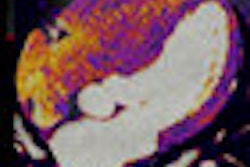Exposure to medical radiation in the U.K. is lower than in other countries, although the level of dose exposure has been creeping higher over the years, according to a new study released January 4 by the U.K. Health Protection Agency (HPA).
Scientists at the agency estimated that the average annual radiation dose to each member of the public in the U.K. from all diagnostic x-rays has increased from 0.33 mSv in 1997 to 0.4 mSv in 2008. CT accounts for about 68% of the U.K. public's exposure to diagnostic x-rays, with 3.4 million CT studies performed in 2008, up 140% from 1997.
Conventional radiographic and fluoroscopic studies contribute 19% of total collective dose, while angiography and interventional procedures constitute 5% and 8%, respectively, of dose exposure. Nuclear medicine was excluded from the HPA study.
Despite the growth in usage, U.K. radiation exposure remains much lower than in other countries. For example, a 2009 study of radiation exposure in the U.S. found that total exposure to medical radiation of all sources (including nuclear medicine) was calculated to be 3.0 mSv. When nuclear medicine radiation is removed, U.S. exposure to medical radiation stands at 2.2 mSv per person, per year (Schauer et al, Radiology, Vol. 253:2, pp. 293-296).
The U.K.'s lower total exposure is due to the fact that fewer x-ray examinations are performed in the U.K. versus other countries, and because U.K. radiology departments "are well managed by healthcare professionals," according to John Cooper, director of the HPA's Center for Radiation, Chemical, and Environmental Hazards.
"It is worth noting that internationally our average annual diagnostic x-ray dose is low," Cooper said in a statement. "In the U.S., for example, people are exposed to five times more radiation from these procedures every year."
The report went on to note that the National Health Service's (NHS) Breast Screening Program accounted for 2.03 million x-ray exams in 2008, an increase of 45% since 1997, when 1.4 million exams were performed. The increase is due to the expansion of the program to women ages 50 to 70, instead of those ages 50 to 64.
Approximately 1.2 million x-ray exams were acquired in independent hospitals in 2008, representing growth of 40% since 1997, while dentists in the NHS system and in private practice performed 12 million x-ray studies (the study pointed out that these exams have a negligible contribution to the overall U.K. radiation exposure because they are low-dose procedures).
By Brian Casey
AuntMinnie.com staff writer
January 5, 2011
Related Reading
Pediatric CT dose is low but varies widely in Belgium, April 23, 2010
CT doses, widely variable in Europe, are reduced by staff efforts, March 6, 2010
320-row CT minimizes dose in pediatric abdominal studies, March 3, 2010
Copyright © 2011 AuntMinnie.com



















